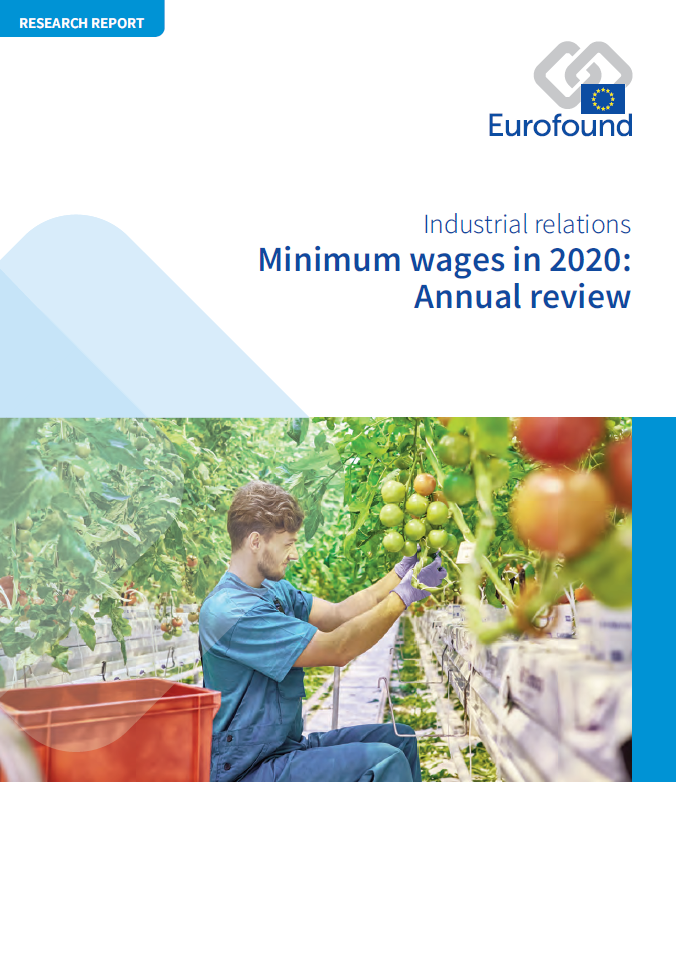
To poročilo, ki je del sklopa letnih pregledov o minimalnih plačah, povzema ključne dogodke v letu 2019 in na začetku leta 2020 v zvezi s pobudo EU o poštenih plačah ter v ta okvir postavlja nacionalne razprave o določitvi stopenj za leto 2020 in naslednja leta. V njem je opisano, kako so bile določene minimalne plače in kakšna je vloga socialnih partnerjev. Poročilo obravnava razvoj dogodkov na področju zakonsko določenih minimalnih plač in predstavlja podatke o minimalnih urnih postavkah v kolektivnih pogodbah, ki se nanašajo na deset slabo plačanih delovnih mest v državah brez zakonsko določene minimalne plače. Vsebuje tudi poglavje o regionalni razsežnosti minimalnih plač in predstavlja najnovejše raziskave o učinkih sprememb minimalne plače na osebne dohodke, zaposlovanje, revščino zaposlenih, cene in dobičke.
Key findings
V letu 2019 je veliko držav razpravljalo o nadaljnjem znatnem povečanju minimalnih plač po letu 2020, delno glede na relativni cilj, delno v absolutnem smislu.
Zakonsko določene minimalne plače so postale pravičnejše v primerjavi z drugimi delavskimi plačami od začetka tisočletja (če se zakonsko določene minimalne plače primerjajo z mediano plač vseh delavcev).
Kljub temu naraščanju minimalne plače v večini držav ostajajo te pod 60 % ali celo pod 50 % mediane plač. To velja zlasti v državah članicah srednje in vzhodne Evrope, ki so na začetku novega tisočletja izhajale iz zelo nizkih relativnih stopenj in v katerih je višina minimalne plače v zakonodaji še vedno določena na ravni približno 50 % mediane ali manj.
Na splošno 7 od 10 delavcev z minimalno plačo poroča, da vsaj deloma težko shajajo s plačo skozi mesec, v primerjavi z manj kot 5 od 10 delavcev, ki prejemajo plačo, višjo od minimalne, vendar pa se te številke močno razlikujejo med posameznimi državami. Na primer skozi mesec se težko ali zelo težko prebija manj kot 10 % delavcev z minimalno plačo na Danskem, Finskem, v Nemčiji in na Švedskem; na drugi strani se te številke gibljejo med 50 % in 60 % v Bolgariji, na Hrvaškem in Cipru ter 80 % v Grčiji.
Vlade v vsej Evropi se odzivajo z različnimi ukrepi za stabilizacijo dohodkov tistih, ki jih je prizadela kriza zaradi nove koronavirusne bolezni. Minimalne plače imajo lahko pomembno vlogo v kombinaciji politik za stabilizacijo dohodkov in s tem zahtevajo ukrepanje za boj proti nezadržnemu slabšanju razmer v recesijo ali depresijo.
Data
Find data on statutory minimum wages in the EU.
- Data: Proportion of minimum wage workers who find it difficult to make ends meet, EU average
- Data: Minimum wage developments in real terms, 15 euro area countries, 2015 price levels
- Data: Proportion of minimum wage workers who find it difficult to make ends meet
- Data: Statutory minimum wages - Minimum wages in the EU in 2020
List of tables
- Table 1: Social partners’ first reactions to the announced initiative on fair wages
- Table 2: Overview of main arguments and proposals concerning an EU minimum wage initiative from social partners
- Table 3: Gross minimum wages, selected EU Member States and the UK, 2019 and 2020
- Table 4: Sub-minimum rates for selected EU Member States and the UK as at 1 January 2020
- Table 5: Further statutory minimum wage rates for private sector workers in selected EU Member States
- Table 6: Number of collective agreements covering low-paying job categories for countries without statutory minimum wages
- Table 7: Minimum wages in collective agreements, applicable in 2019 for selected low-paid jobs
- Table 8: Collective agreement coverage in Finland
- Table 9: Overview of debates during 2019 on aspects of the minimum wage setting processes
- Table 10: Demands for and agreements on targets for future minimum wages to address adequacy in selected EU Member States and the UK
- Table 11: Regional statutory minimum wage rates
- Table 12: Latest minimum wage research in EU Member States and the UK
- Table 13: Overview of recent empirical research in the EU, Norway and the UK on employment impacts of minimum wage increases, 2019
- Table 14: Policies influencing in-work poverty
- Table A1: Network of Eurofound Correspondents – Members participating in the research
List of figures
- Figure 1: Conceptualising adequate minimum wages
- Figure 2: Estimated share of employees earning 90% to 110% of the minimum wage, EU Member States, 2017
- Figure 3: Proportions of female and male employees, EU level, 2017
- Figure 4: Proportion of minimum wage workers per sector, EU level, 2017
- Figure 5: Proportion of minimum wage workers per occupation (top 10), EU level, 2017
- Figure 6: Hourly minimum wages, selected EU Member States, 2020
- Figure 7: Minimum wage developments in real terms, 15 euro area countries, 2015 price levels
- Figure 8: Minimum wage developments in real terms, non-euro area, 2015 price levels
- Figure 9: Impact of purchasing power on the minimum wage value for selected EU Member States and the UK, as at 1 January 2020
- Figure 10: Relative distance between purchasing power of lowest and median minimum wage EU Member States and the UK and highest minimum wage EU Member States and the UK, 2010–2020
- Figure 11: Process for determining minimum wage rates for 2020
- Figure 12: Number of minimum wage rate updates, EU Member States with statutory minimum wages and the UK, since 2010
- Figure 13: Longer-term trend of development of statutory minimum wages relative to median wages of full-time employed workers, selected countries within the EU and the UK, 2000–2018
- Figure 14: Proportion of minimum wage workers who find it difficult to make ends meet, EU average
- Figure 15: Proportion of minimum wage workers who find it difficult to make ends meet
- Figure 16: Making ends meet and minimum wages in relative and absolute terms
- Figure 17: Monthly minimum wage as a proportion of the mean value of average monthly earnings by NUTS1 region, reference year 2016
- Figure 18: Regional variation of relative monthly minimum wages, by NUTS1 region, 2016
- Figure 19: Examples of countries with higher interregional differences in the proportion of minimum wage workers
- Number of pages
-
86
- Reference nº
-
EF20005
- ISBN
-
978-92-897-2068-7
- Catalogue nº
-
TJ-AS-20-001-EN-N
- DOI
-
10.2806/999852
- Permalink
Cite this publication
